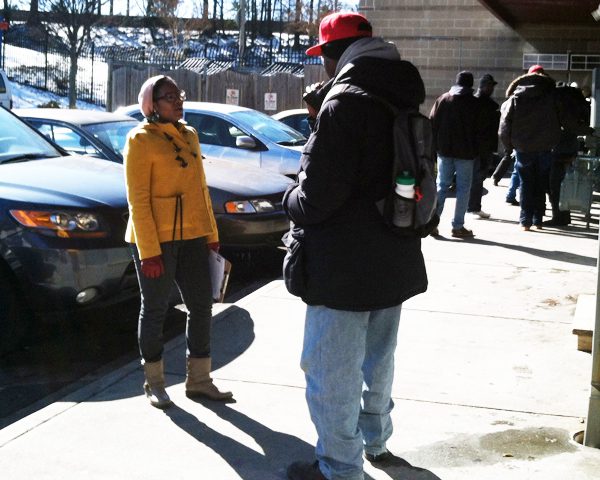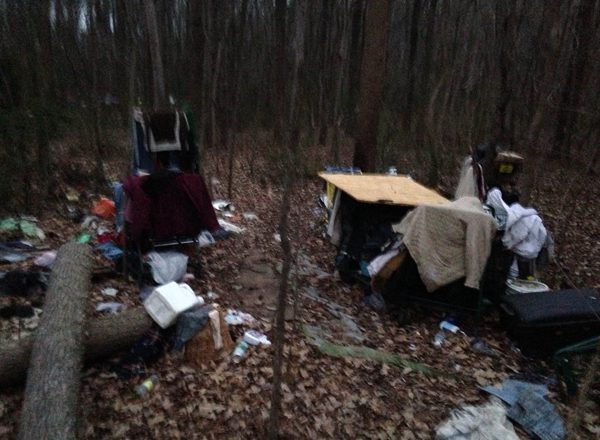Defining home: Charlotte counts the homeless

Home. The word means many different things to many different people. For some, it might be a house. For others, it might be a park bench or a tent behind a supermarket. Just as homes can take many forms, so can homelessness.
I was forced to reflect on this last month, as a volunteer with the street outreach portion of the point-in-time count, where we saw tangible evidence of how “home” for some Mecklenburg County residents can look very different from a traditional home.
On a cold morning in January, two coworkers at the UNC Charlotte Urban Institute, a volunteer leader and I all met at 5:45 a.m. to take part, with another 100 volunteers, in the street outreach portion of the Charlotte/Mecklenburg County point-in-time count (PIT). This year’s count of homeless people, part of a national effort, was one of the most comprehensive ever conducted in our community.
The count takes place in January, aiming to take a census of all homeless people – sheltered or not – on a given night. Charlotte’s official PIT count was Wednesday, Jan. 29, with additional street outreach efforts Tuesday and Thursday. In addition to the count, volunteers surveyed homeless people they found, to assess their vulnerability, and provided plastic baggies of socks, snacks and other helpful items.
Over three days, volunteers walked and drove throughout Mecklenburg County, in search of people living in places unfit for habitation. Our volunteer team was in charge of covering an area in north Charlotte, primarily along Sunset Boulevard. The area, although still urban, is remote from uptown and the many services there.
As we drove through the streets of north Charlotte, we stopped at fast food restaurants, motels and gas stations to talk with employees about whether any homeless people frequented their businesses. Often, workers mentioned that homeless individuals would come in to stay warm and get food during the day, but they didn’t know specifics of where they were living.
 We crossed railroad tracks and climbed hills, using flashlights to explore the woods secluded behind shopping centers.
We crossed railroad tracks and climbed hills, using flashlights to explore the woods secluded behind shopping centers.
We saw signs of people living there. At times it even felt as if we were intruders in someone’s home, although it was not what we’d typically call a “home.” We encountered tents, areas for hanging laundry, areas for shopping carts and makeshift sleeping or sitting areas.
We had suggestions in advance for where to explore, based on information people submitted in response to an article in the Charlotte Observer, or from police. Police, often familiar with where homeless encampments might be found, were strong allies in the count. Their involvement was especially important because so many homeless people keep to hidden places. For those of us volunteering beyond downtown Charlotte, that help was crucial in knowing where to look.
However, in two mornings of searching, our team identified only two homeless individuals, despite seeing signs of many more. We knew that for each person we could not find and count, it would mean one less person to be identified as needing resources. Although we hope they were counted at the various homeless shelters, there is no way to know.
The count this year happened to be on a snowy day, unusual for Charlotte, and that severely limited volunteers’ ability to find people. Because of the cold, the homeless were less likely to be in their camps and more likely to have sought a warm place. Therefore this year’s count may not be an accurate comparison with last year’s.
It can’t be known where many of the homeless went during the cold. We hoped many were included in the count at the Red Cross uptown warming station and other shelters. Homeless people farther out in the county might have found abandoned buildings, cars or other places to stay – and so missed being counted.
As a volunteer, I found it humbling to think some people would be spending the night outside in the freezing cold, when after 10 minutes of walking outside, I was ready to hop back in the car and blast the heat – a luxury many do not have.
This year’s street outreach volunteer effort identified 165 adults and 6 children, and the majority had been homeless more than a year. That’s fewer than last year’s street count of 283. It is important to note though, that the methods used for the two studies vary greatly. Also, only 164 of these individuals were counted Wednesday, the official count day, and will be included in the official PIT count.
But even for homeless people not officially counted, it was important to identify and collect information on as many as possible, in order to better target and provide outreach services. Of those surveyed this year, 50 were identified as vulnerable, or having an increased mortality risk; 49 had physical health issues, 63 had mental health issues and 83 had substance abuse problems.
This year’s volunteer outreach effort was one of the biggest ever taken in Charlotte, important because for every person counted, that will help bring more federal resources to our community.
The count also helps us better understand homelessness in Charlotte and how to provide our homeless residents with stable, permanent, and affordable shelter – a place they can eventually call home.